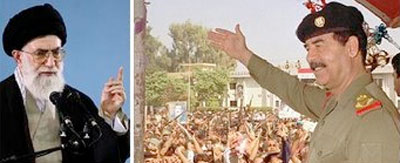
On June 9 the U.N. Security Council approved Resolution 1929 which imposes further sanctions on Iran for its lack of cooperation with the International Atomic Energy Agency (IAEA). U.S. officials hope that the resolution, combined with follow-on sanctions imposed by the European Union and others, will encourage Iran to fully cooperate with the inspections or return to negotiations. Failing that, the White House hopes that the new sanctions — which target Iran’s nuclear program, its ballistic missile effort, and its conventional military forces — will disrupt and delay the country’s nuclear and conventional military potential.
In remarks he made the same day, President Barack Obama agreed with the vast majority of analysts who hold out little hope that Iran’s leadership will reverse course any time soon. That leaves the hope that sanctions will materially degrade Iran’s nuclear and military programs. They might, but how will the international community know how much? From 1991 to 2003, Saddam Hussein’s Iraq tormented U.S. policymakers with inspection-dodging and intelligence uncertainty. It looks like a new generation of U.S. officials is about to experience similar taunting from Iran.
Iranian leaders have no doubt closely studied how Iraq resisted the Security Council’s attempts to rein in its military potential after the 1991 war. In the early years of the Clinton administration, Iraq was in technical compliance with the post-war inspection requirements, but this cooperation was grudging, increasingly belligerent, and was eventually terminated. Iran’s cooperation with the IAEA is already incomplete and in the wake of Resolution 1929, Tehran has to reduce it further. Through a combination of humanitarian appeals, back-channel deal-making, and bribery, Iraq was able to wear down and divide the international consensus that existed after the 1991 war. Iran has similarly found friends in Turkey and Brazil and is likely to find more in the developing world (some of whom might have their own nuclear ambitions) in the period ahead.
The goal of a sanctions strategy is to avoid either a regional arms race or the necessity of a military response. We will know that sanctions have worked if the Iranian government returns to negotiations, settles the nuclear issue, and opens itself fully to IAEA inspections, but very few observers expect such an outcome. What will remain are the sanctions, which in turn will lead to Iranian resistance, inspections-dodging, an intelligence black hole, and ominous strategic uncertainty. In the case of Iraq, these factors led to war in 2003. Needless to say, this is not an experience U.S. policymakers will be anxious to repeat. Iran’s leaders are aware of this understandable hesitancy and thus have little reason to fear suffering Saddam’s fate.
What is ironic in retrospect is how effective sanctions against Iraq (combined with the four-day Desert Fox air campaign in December 1998) turned out to be at weakening the country’s once-formidable military power. But no Western intelligence agency knew the full extent of this effectiveness until after 2003. When pondering the mystery of Iran’s future nuclear capabilities, other countries in the region are unlikely to get much comfort from this precedent. From their perspective, prudence in the face of uncertainty will require additional defensive and retaliatory capabilities. Thus, sanctions are not likely to prevent an arms race in the region, an outcome the Obama administration hopes to avoid.
Now that Resolution 1929 is in place, what subsequent moves do Obama administration officials contemplate? Hopefully they’ve been studying Iraq’s experience as well.
First published in ForeignPolicy.com.
AUTHORS
Robert Haddick is managing editor of Small Wars Journal.






